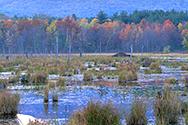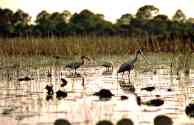
 Wetlands:
Functions
Wetlands:
Functions
Wetlands are often considered muddy, bug-filled, disease-ridden wastelands. However, scientists have discovered that wetlands serve three very important functions in nature: they clean the environment, provide habitat for many organisms, and store energy.
Photo: A swamp near Center Sandwich, New Hampshire. Photo courtesy of Philip
Greenspun.
Wetlands microorganisms, as well as wetlands plants, serve as environmental filters by trapping impurities such as
toxins and excessive nutrients as water flows through the wetlands system. Meanwhile, wetlands plants strain silt and larger debris from the water. The wetlands plants and sediment also serve to balance nutrient sources and
sinks. For example, wetlands plants produce oxygen that is used by other wetlands organisms, while the sediment contributes to environmental health by trapping atmospheric carbon. Too much atmospheric carbon can contribute to global climate change. In addition, wetlands serve as environmental sponges, absorbing and temporarily storing excess water caused by runoff, thus preventing flooding.
 Wetlands also provide a home or habitat for many
species of microorganisms, plants and animals. Wetlands serve as a resting place for migratory birds and a nursery for many young animals. The microorganisms, plants, and animals that find shelter in the wetlands serve as food for other microorganisms, plants, and animals.
Photo: Birds feeding in Savannas in St. Lucie County, Florida. Photo courtesy of South Florida Water Management District.
Wetlands also provide a home or habitat for many
species of microorganisms, plants and animals. Wetlands serve as a resting place for migratory birds and a nursery for many young animals. The microorganisms, plants, and animals that find shelter in the wetlands serve as food for other microorganisms, plants, and animals.
Photo: Birds feeding in Savannas in St. Lucie County, Florida. Photo courtesy of South Florida Water Management District.
Lastly, wetlands provide a sink in which
energy is stored. Energy is the ability to do
work. Having energy is very important because it is required by all organisms for life. Energy from the sun is acquired directly by plants. Through the process of
photosynthesis, plants convert the sun's energy into carbon-containing compounds. The sun's energy is released from these carbon-containing compounds when they are broken down during
combustion (burning) or during respiration by animals that have consumed the plants. Plants that are not burned or eaten eventually die and slowly decompose. The decomposing plant matter builds up to form carbon-rich deposits called peat. Over the course of millions of years, great temperatures and pressures transform the peat into
coal and oil. These fuels are then burned by people in order to release the energy trapped inside the carbon-rich material. This energy does work such as moving an automobile.
For more information on wetlands functions, visit:
National Wildlife Federation Kids: What Is a Wetland?
Nebraska Game and Parks Commission: Wetland Functions and Values
EPA Wetlands Homepage
Overview
..|..
Species
..|..
Functions..
..|..
Management
Glossary
..|..
Related
Links
..|..
References
|..PBL
Model
Home ..|.. Teacher Pages ..|.. Modules & Activities
HTML code by Chris
Kreger
Maintained by ETE Team
Last updated
April 28, 2005
Some images © 2004 www.clipart.com
Privacy Statement and Copyright © 1997-2004 by Wheeling Jesuit University/NASA-supported Classroom of the Future. All rights reserved.
Center for Educational Technologies, Circuit Board/Apple graphic logo, and COTF Classroom of the Future logo are registered trademarks of Wheeling Jesuit University.

